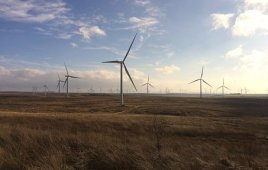
Looks like trouble. The weak crawlway is cracking and the crane is tilting.
A large crawler crane on a wind farm with a soft soil was on its way, fully equipped, to its next installation when soil mechanics took over. The crane, a Liebherr LTR 11200, is a telescopic crawler crane on a narrow track. The 415-ton giant required that every square meter of soil support 16.5 tons. At one point, the soft soil got the better of the crane and its tracks started to sink into the ill-prepared track way. Six-in. cracks suddenly appeared in the gravel path between the crawler tracks.
As one side of the track sank, the crane tipped to a dangerously inclined position. The man at the controls wisely decided to secure the machine so he promptly extended its jack pads mounted at the ends of outspread star-shaped supports, to press into the soft ground. Despite the boggy soil, the contact surface was large enough to stabilize the crane and bring it back into a horizontal position. So, just when things were getting precarious, the safety procedure planned the manufacturer for just such a scenario worked perfectly.
The man at the controls was Burkhardt Hartinger, Liebherr VP of the crane business. The crane’s narrow track, about 4.8 m wide, makes the crane well suited for traveling narrow trackways, like those often encountered on wind farms. The only problem here was that the constructed road could not support the machine’s enormous load.

Support arms stabilize the crane keeping it upright untill balast can be removed.
Anticipating trouble from the soft ground, Hartinger had spread the pads arms of the LTR 11200 before setting out on the move. As he lifted the supporting pads to let his men slide large timbers beneath the pads. The problem was to stabilize the crane further, and take off part of the equipment so it could travel the rest of the way. Time was short because a crew was waiting at the next installation. The ground there was better prepared. The surface had been excavated 4-m down and backfilled with gravel.
The crane crew removed the lattice boom and 80 tons of ballast from the machine in three hours. The gravel track was just wide enough for the crawler travel gear. Moving the crane fully equipped was something that had previously exercised Hartinger’s skill, but the speed at which it can be done is impressive, he says. “We only needed three to four hours to get from one site to another, about 500 meters away,” he adds.
A useful accessory to Hartinger’s LTR 11200 is a smaller version of the telescopic crawler crane, an LTR 1100. This mobile 100-ton crane assists setting up the tower elements and the generator, working with the personnel basket, and, of course, carrying out equipment work on the large crane. At the bog site, the LTR 1100, unlike a mobile crane with wheels, can venture a certain distance into the bog, and is incomparably faster when it comes to moving location. It can even travel with a load. The compact Liebherr crawler cranes have 52-m telescopic booms.
 Back at the site, Hartinger and his crane completed the wind farm, by erecting a total of six Enercon E-82 turbines, each with a 108-m hub height. The heaviest and most difficult part in each case was the rotor, weighing in at 51 tons. It had to be fitted complete and lifted with an outreach of some 18 m.
Back at the site, Hartinger and his crane completed the wind farm, by erecting a total of six Enercon E-82 turbines, each with a 108-m hub height. The heaviest and most difficult part in each case was the rotor, weighing in at 51 tons. It had to be fitted complete and lifted with an outreach of some 18 m.
Watch a video on Liebherr crawler cranes here
Filed Under: Construction




